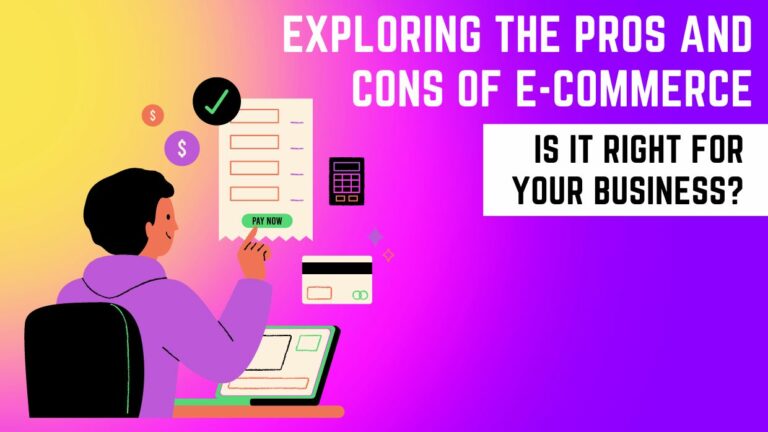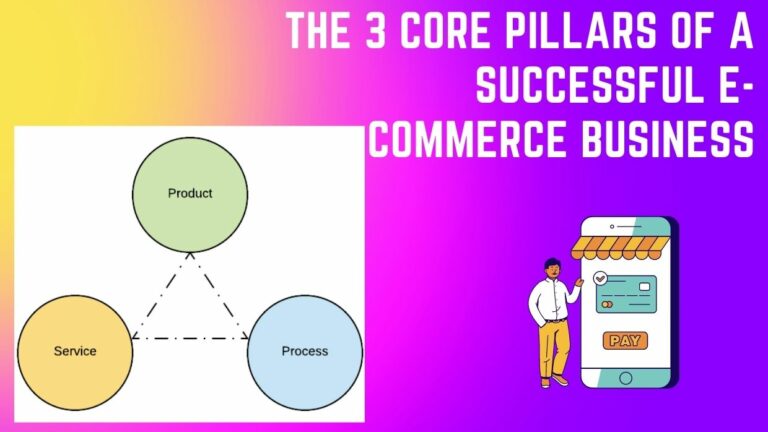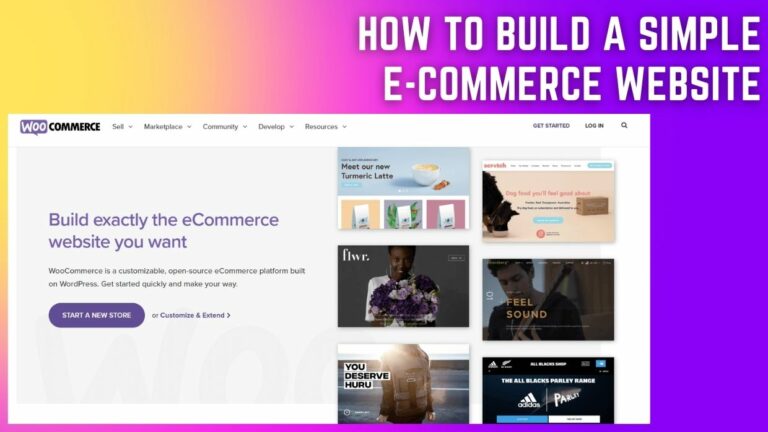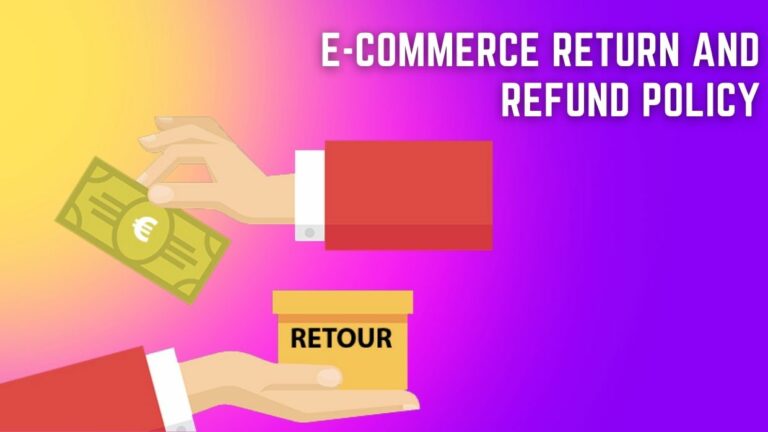Your Step-By-Step Guide To E-commerce
Are you looking for a way to get started selling online? E-commerce is a great option for entrepreneurs that want to set up their own businesses. But it can be daunting if you don’t know where to start. In this article, we’ll look at the step-by-step guide on how to get your e-commerce store up and running today!
Introduction to E-Commerce
E-commerce, or electronic commerce, is the buying and selling of goods and services online. E-commerce businesses can range from small, home-based businesses to large, international enterprises. No matter the size of your business, if you’re selling products or services online, you need to have a solid e-commerce plan in place.
Creating a successful e-commerce business takes more than just setting up a website and adding products. You need to take into account things like shipping and delivery, payment methods, customer service, and return policy.
In this guide, we’ll walk you through everything you need to know to get started with e-commerce. We’ll cover the basics of setting up your store as well as some tips and tricks for making sure your customers keep coming back.
By the end of this guide, you’ll have all the knowledge you need to get started selling online today!
learn more… What Is E-Commerce? An Essential Guide To Understanding Online Shopping
Benefits of Selling Online
There are many benefits to selling online. Perhaps the most obvious is that it gives you access to a much larger market than you could reach offline.
Selling online also gives you more control over your pricing, inventory, and marketing than you would have if you were selling through brick-and-mortar stores. And, because customers can purchase from you 24/7, selling online can help you boost your sales and grow your business.
Steps to Setting Up an E-commerce Store
Assuming you already have a product or service to sell, there are only a few steps left before you can start selling online!
- Choose an eCommerce platform: In order to start selling online, you’ll need to choose an eCommerce platform or website builder to create and host your store. There are many different options available, so be sure to do your research before making a decision. Some popular eCommerce platforms include Shopify, WooCommerce, and BigCommerce.
- Set up payment processing: Once you’ve chosen your platform, you’ll need to set up a payment processor so that customers can pay for your products or services online. Again, there are many different options available (e.g., PayPal, Stripe), so be sure to compare the fees and features of each before making a decision.
- Choose your shipping method: Unless you plan on offering digital products only, you’ll need to decide how you want to ship your products to customers. Will you use a fulfillment service like Shipstation or Fulfillment by Amazon? Will you ship orders yourself? The shipping method you choose will likely depend on the type of product(s) you sell and your budget.
- Create marketing campaigns: Once everything is set up and ready to go, it’s time to start promoting your store! There are many different ways to market an eCommerce store (e.g., social media, email marketing, search engine optimization), so be sure to research the best strategies for your particular industry.
- Monitor performance: Once your store is up and running, you’ll need to monitor its performance in terms of sales, customer satisfaction, etc. You can use analytics tools like Google Analytics or Shopify analytics to keep track of how well your store is doing. This will help you make informed decisions about how to improve your store over time.
Choosing the Right Platform
When it comes to setting up an e-commerce store, the platform you choose can make or break your business. There are a lot of different options out there, and it can be tough to know which one is right for you. To help you make the best decision for your business, we’ve put together a guide to choosing the right e-commerce platform.
The first thing you need to do is figure out what your needs are. What kind of products are you selling? How many products do you have? What kind of features do you need? Once you know what you need, you can start looking at different platforms.
Shopify is a great option for businesses that are just starting out. It’s easy to use and has all the features you need to get started. Plus, there are plenty of Shopify experts out there who can help you if you run into any problems.
If you’re looking for something a little more robust, Magento is a good choice. It’s a bit more complex than Shopify, but it has a lot of powerful features that businesses need as they grow. Again, there’s no shortage of experts who can help you if you run into any problems.
Once you’ve decided on a platform, it’s time to start setting up your store. This is where things can get a bit tricky, but don’t worry – we’ll be here to help you every step of the way. Just follow our simple setup guide and you’ll be ready to start selling in no time.
We hope this guide has been helpful in choosing the right e-commerce platform for your business. Good luck!
Designing Your Website
If you’re reading this guide, it’s likely that you’re considering starting an e-commerce business. But where do you start? The process of designing and launching an online store can seem daunting, but we’re here to help.
In this section, we’ll walk you through the process of designing your website, from choosing a domain name to selecting a theme to set up your payment gateway. By the end, you’ll have a beautiful online store that’s ready to start selling.
Payment Processing Solutions
There are a lot of different payment processing solutions out there for e-commerce businesses. But which one is the best for your business?
To help you make the best decision for your business, we’ve put together a guide to the most popular payment processing solutions. We’ll go over the pros and cons of each solution, so you can decide which one is right for you.
The most popular payment processing solutions are:
- PayPal
- Stripe
- Authorize.Net
- Braintree
- 2Checkout
Marketing Strategies for Selling Online

There are a number of marketing strategies you can use to sell online, and the best approach depends on your products, services, and target market.
Here are some tips to get you started:
- Use social media to reach your target market.
If you’re selling products or services that appeal to a specific demographic, then you need to make sure you’re active on the social media platforms they use most. This way you can reach them where they already are and start building relationships.
- Create compelling content.
No matter what platform you’re using, whether it’s social media or your own website, the key to selling online is creating compelling content that speaks to your target market’s needs and desires. Make sure your content is well-written, informative, and visually appealing, and be sure to update it regularly.
- Use search engine optimization (SEO).
If you want people to find your products or services online, then you need to make sure your website is optimized for search engines. This means using the right keywords in your titles and descriptions, as well as making sure your site is easy to navigate and loads quickly.
- Invest in paid advertising.
Paid advertising can be an effective way to reach potential customers who might not find your site otherwise. When done correctly, paid ads can also be very cost-effective since you only pay when someone clicks on your ad. Just be sure to do your research to make sure you’re targeting the right people.
- Consider affiliate marketing.
If you want to reach more potential customers without doing all the work yourself, then affiliate marketing can be an effective strategy. With this approach, you partner with other websites that have similar target markets as yours and pay them for referring customers to your site.
- Offer discounts and promotions.
Everyone loves a good deal, so offering discounts or promotional codes can be a great way to entice people to buy from you. This could include things like free shipping or limited-time discounts on certain products or services.
- Build an email list of customers.
Your existing customers are some of your best assets when it comes to selling online, so be sure to build an email list of them so you can keep in touch and send out periodic updates about new products, services, sales, etc.. This will help keep them engaged and coming back for more.
Customer Service & Support
Customer service and support is critical for any business, but it’s especially important for ecommerce businesses. Because customers are buying products and services online, they can’t physically come into a store or office to ask questions or get help with problems. That means it’s up to you, the business owner, to provide excellent customer service and support.
There are a few things you can do to make sure your customers are happy:
Respond quickly to customer inquiries. Customers should feel like they’re your top priority, so respond to their questions and concerns as quickly as possible.
Offer multiple channels of support. Some customers prefer to communicate via phone, while others prefer email or live chat. Offering multiple channels of support will ensure that all customers can get the help they need.
Be friendly and helpful. This one should go without saying, but it’s important to be friendly and helpful when communicating with customers. Remember, the goal is to keep them happy!
Providing excellent customer service and support is an important part of running a successful ecommerce business. By following the tips above, you can make sure your customers are always happy with your products and services – no matter what!
Analyzing Your Results
Assuming you’ve followed all of the steps in this guide so far, you should now have a functioning online store! Congratulations! Now it’s time to analyze your results and see how your business is doing.
There are a few key metrics you’ll want to track:
- Sales: This one is pretty self-explanatory. How much revenue are you bringing in?
- Traffic: How many visitors are coming to your site? Where are they coming from?
- Conversion rate: What percentage of visitors are actually purchasing something?
- Average order value: How much are people spending per transaction?
- Customer lifetime value: How much is each customer worth to you over the course of their relationship with your business?
You can find most of this data in your e-commerce platform’s built-in analytics tools. If you’re using Shopify, for example, they have a comprehensive dashboard that shows all of this information (and more).
Once you have a good understanding of how your business is performing, you can start making changes and tweaks to improve things. Maybe you need to invest in some paid advertising to drive more traffic, or maybe your conversion rate could use some improvement.
Whatever the case may be, now you have the data you need to make informed decisions about where to take your business next.
Conclusion
Starting an e-commerce business is a great way to gain financial freedom and build the life of your dreams. With the right tools, techniques, and strategy in place, you can start selling online today with ease.
We hope that our step-by-step guide has helped you understand all the steps necessary to get started on your ecommerce journey. What are you waiting for? It’s time to take control of your future and make money online with an e-commerce business!







